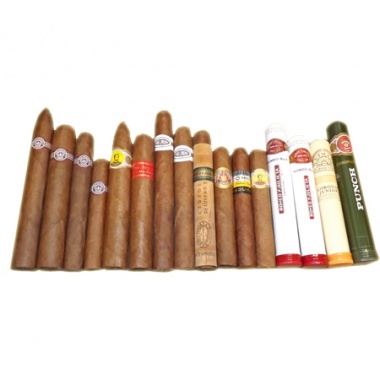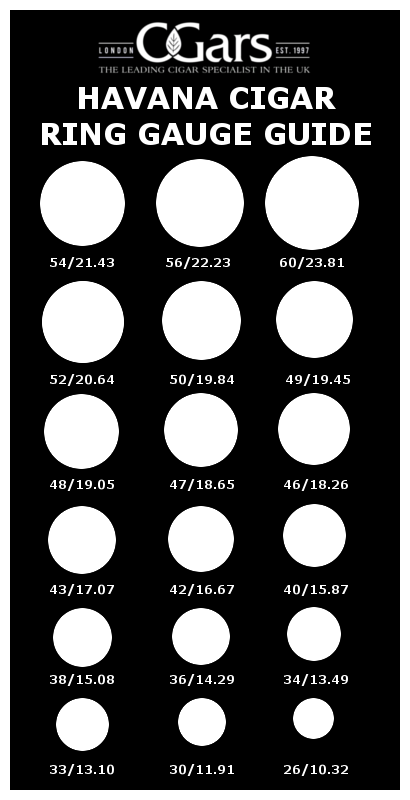
This site contains tobacco images. Please leave now if you are under 18
 Cigars come in many shapes and sizes and colours. It is often difficult for a neophyte cigar smoker to get a complete understanding of the how these factors affect the taste. The shape of the cigar is perhaps the hardest thing to describe since there are no set standards used between cigar manufacturers. Usually it is best to remember the shape written on the box to remember what you are smoking.
Cigars come in many shapes and sizes and colours. It is often difficult for a neophyte cigar smoker to get a complete understanding of the how these factors affect the taste. The shape of the cigar is perhaps the hardest thing to describe since there are no set standards used between cigar manufacturers. Usually it is best to remember the shape written on the box to remember what you are smoking.
The size is measured by length and ring gauge (cigar's diameter). One ring is equivalent to 1/64 of an inch. Some of the most common are Panatela (6 1/2 x 35), Robusto (4 1/2 x 50), Churchill (7 1/4 x 48), Corona (5 3/4 x 42), Double Corona -another favourite (6 1/2 x 48), and Lonsdale (6 3/4 x 42) to name a few. A cigar with a larger ring gauge will have a fuller and more complex flavour and produce more smoke compared to the smaller ring gauge cigars. The larger a ring gauge the more a cigar maker can blend and combine different types of leaves.
Colour also plays an important part in choosing your cigars. What you see when you look at a cigar is the wrapper and it plays a role in the flavour of your cigar. Usually the wrapper is described by it's country of origin or colour; Claro (light tan), Maduro (darkest brown), Oscuro (black), Colorado (reddish dark brown), Colorado Maduro (dark brown), Colorado Claro (mid brown). Also when you look at the wrapper make sure it isn't too dry not feel too firm or too soft. Before you buy check for cracks or defective wrapper.
The world's finest cigars vary in size from about a 9 x 64 (which is one inch wide) down to approximately 4 x 30. The first number refers to the cigar's length, in inches; the second is it's ring gauge, or the thickness of the cigar, measured in sixty-fourths of an inch. Most cigar smokers gravitate to a particular size, so when considering the quality and consistency of taste and aroma of a cigar, your sense of comparability can be confused and it will be difficult to judge fairly unless you're smoking the size you're accustomed to. The same cigar blends in different sizes taste different, sometimes vastly different, because of the different ring sizes and lengths. A big ring gauge, 50 or 52, produces an immense volume of smoke compared with a 28, 36 or even a 42.
 Strength of Cigar
Strength of CigarCuba is unique to the extent that all Havanas or Habanos are blended from tobaccos grown on the island. They tend to offer medium to full flavours but the enormous variety of leaves available produce surprisingly mild smokes in certain brands. Cigars from other places like the Dominican Republic and Honduras are usually made from tobaccos taken from several countries. Hard and fast rules on flavours are therefore impossible to lay down. As a rough guide: Cigars with Dominican fillers tend towards mildness; maduro wrappers bring a sweetness to the taste, and in general Honduran and Nicaraguan fillers add spiciness.
The colour of a cigar's wrapper, the capa, is generally the key to it's flavour. The darker the wrapper, the more full-bodied and sweeter a cigar is likely to be, although the true determinant is the colour of the filler. A few important variables effect the final flavour and quality of wrapper leaves: their location on the plant; when they are harvested; and how they are fermented or dried. The longer a leaf stays on the plant and the more sunlight it receives, the darker it will be. Cigar wrappers can be classified into seven basic colours, although there are dozens of possible shades. The basic colours of wrappers range from Claro (pale brown) to Oscuro (black).Click here to view Wrapper Colours
Cigars fresh out of the box are generally too young to smoke. While some things like lettuce are best enjoyed fresh, cigars taste bitter when smoked without proper ageing. I recommend that cigars are kept in a humidor for about a year and allowed to rest and release any toxic gases like ammonia which may be lingering in the leaf. Some cigars keep better for longer times, such as a good Cuban like a Bolivar, or Montecristo. Some better brands of Dominican or Honduran cigars hold up to aging well: strong wrappers are a must. Aging your cigars will bring out the best flavours and can turn a fair cigar into a winner using the magic of time.
While you can keep your cigars in the box they came in from the store, unfortunately they will dry out and become stale in a matter of weeks. The best place to store your fine cigars is in a humidor. Good humidors come in a variety of materials and sizes. You can find them made from exotic woods like Canary wood, or from pleasing grain woods such as cherry or maple. The inside should be Spanish cedar and have method of testing the humidity. Larger humidors have partitions to separate your various cigar brands. When purchasing a new humidor one should pay special attention to the hinge. In addition you may want to consider a locking mechanism to keep your stash safe from your "friends".
The most important thing to know about storing your cigars is that they must be store at 65 to 70 degrees of humidity and at a temperature of approximately 70 degrees fahrenheit. Just remember the 70/ 70 rule. Good humidors come with a device to maintain the proper level of humidity. There must be care taken when humidifying cigars, as excessive moisture can cause mould to grow, which will ruin everything in the box. A good strategy is to rotate your stock from top to bottom, which will help evenly distribute the moist and dry cigars within your humidor. If you buy a box and they are green or 'fresh' you can lay them away, and test one cigar every three to 6 months.
The tiny dots which may appear after a time are called bloom. A certain amount of bloom is a sign of proper aging. Brush it off and enjoy your cigar. If you see little bugs running around in your cigar box you have a problem. You need to separate out the offending area of cigars, and may require you to dump your entire inventory. The combination of over humidification and higher than recommended temperature, will cause Lacioderma bugs to hatch. Keeping your humidor at 70 or below degrees fahrenheit at 70 degrees humidity will help avoid this from happening to you. It is a rare event, so relax and don't worry about this at all.
Travel humidors are also good to have if you want to smoke a cigar when away from your home. Good storage techniques will keep your investment safe and sound. Letting your cigars age will result in greater enjoyment when flame hits leaf. Let me and the other readers know if you have any tips on storing or aging good or great cigars!
The three criteria for appreciating a fine cigar are similar to those applied to fine wines: flavour, body and aroma.
Flavour: Taste can discern four basic categories: sweet, bitter, salty, and acid. Bitter and sweet are the easiest to detect, the other a bit more difficult, and they are subjective. Connoisseurs use terms like fruity, nutty and herbal, spicy, and floral, to refer to the combination and balance of tastes. They identify such flavour notes as pepper, wood, nut, cream, coffee, nutmeg, cinnamon, citrus, cedar, chocolate, and leather. The classifications mild, medium and full refer to the degree of flavour.
Body: The body of the smoke refers to the strength of the tobacco, its overall effect on the smoker. It's degrees are light, medium, and heavy.
Aroma: The aroma of a cigar is one that pleases you.There are also two crucial elements:
While taste and aroma are important attributes for the consistently well constructed cigar, there are other indicators as well. When a cigar is properly lit, it should burn evenly all the way down, an uneven burn is a sign of an improper roll. The ash should be relatively firm, remaining intact for an inch or more without difficulty (with the exception of small ring-gauge cigars).
A falling ash is not necessarily a sign of poorly constructed cigar, but if your cigar develops a firm, even ash while you're smoking, its an indication that it is well made. A cigar should have a good mouth feel. While it is never really recommended to chew the end, the cigar should feel firm and resistant in the mouth. If the cigar is soft, its another sign of poor construction. It won't feel good either, and you won't enjoy it.